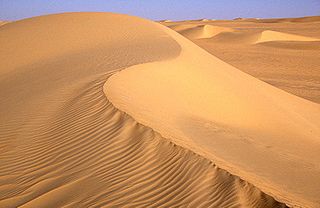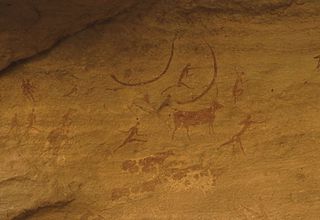
Niger or the Niger, officially the Republic of the Niger, is a landlocked country in West Africa. It is a unitary state bordered by Libya to the northeast, Chad to the east, Nigeria to the south, Benin and Burkina Faso to the southwest, Mali to the west, and Algeria to the northwest. It covers a land area of almost 1,270,000 km2 (490,000 sq mi), making it the second-largest landlocked country in West Africa, after Chad. Over 80% of its land area lies in the Sahara. Its predominantly Muslim population of about 25 million live mostly in clusters in the further south and west of the country. The capital Niamey is located in Niger's southwest corner.
This is the history of the Niger. See also the history of Africa and the history of West Africa.

The Prehistory of North Africa spans the period of earliest human presence in the region to gradual onset of historicity in the Maghreb (Berber:Tamazgha) during classical antiquity.

The Sahara is a desert on the African continent. With an area of 9,200,000 square kilometres (3,600,000 sq mi), it is the largest hot desert in the world and the third-largest desert overall, smaller only than the deserts of Antarctica and the northern Arctic.

A tumulus is a mound of earth and stones raised over a grave or graves. Tumuli are also known as barrows, burial mounds or kurgans, and may be found throughout much of the world. A cairn, which is a mound of stones built for various purposes, may also originally have been a tumulus.

The Ténéré is a desert region in the south central Sahara. It comprises a vast plain of sand stretching from northeastern Niger into western Chad, occupying an area of over 400,000 square kilometres (150,000 sq mi). The Ténéré's boundaries are said to be the Aïr Mountains in the west, the Hoggar Mountains in the north, the Djado Plateau in the northeast, the Tibesti Mountains in the east, and the basin of Lake Chad in the south. The central part of the desert, the Erg du Bilma, is centred at approximately 17°35′N10°55′E. It is the locus of the Neolithic Tenerian culture.

Prehistoric Egypt and Predynastic Egypt span the period from the earliest human settlement to the beginning of the Early Dynastic Period around 3100 BC, starting with the first Pharaoh, Narmer for some Egyptologists, Hor-Aha for others, with the name Menes also possibly used for one of these kings.

Saharan rock art is a significant area of archaeological study focusing on artwork carved or painted on the natural rocks of the central Sahara desert. The rock art dates from numerous periods starting c. 12,000 years ago, and is significant because it shows the culture of ancient African societies.

The Tanezrouft is a natural region located along the borders of Algeria and Mali, west of the Hoggar Mountains. Along with the Libyan Desert it is one of the most desolate and most arid parts of the Sahara Desert. This area has no permanent residents and is known for its soaring temperatures and scarce access to crucial resources: water and food. Due to this, it is commonly referred to as the "land of terror".
Jobaria is a genus of sauropod dinosaur that lived in what is now Niger during the middle Jurassic Period, between 164 and 161 million years ago. Jobaria is currently the only known valid sauropod from the Tiouraren, where it was discovered in 1997.

Paul Callistus Sereno is a professor of paleontology at the University of Chicago and a National Geographic "explorer-in-residence" who has discovered several new dinosaur species on several continents, including at sites in Inner Mongolia, Argentina, Morocco and Niger. One of his most widely publicized discoveries is that of a nearly complete specimen of Sarcosuchus imperator — popularly known as SuperCroc — at Gadoufaoua in the Tenere desert of Niger.
Uan Muhuggiag is an archaeological site in Libya. It was occupied by pastoralists during the early- to mid-Holocene. The site is where the Tashwinat Mummy was found, which was dated to around 5600 BP. It now resides in the Assaraya Alhamra Museum in Tripoli.
The Kiffian culture is a prehistoric industry, or domain, that existed between approximately 8,000 BC and 6,000 BC in the Sahara Desert, during the African humid period referred to as the Neolithic Subpluvial. Human remains from this culture were found in 2000 AD at a site known as Gobero, located in Niger in the Ténéré Desert. The site is known as the largest and earliest burial place of Stone Age people in the Sahara desert.

Nigersaurus is a genus of rebbachisaurid sauropod dinosaur that lived during the middle Cretaceous period, about 115 to 105 million years ago. It was discovered in the Elrhaz Formation in an area called Gadoufaoua, in Niger. Fossils of this dinosaur were first described in 1976, but it was only named Nigersaurus taqueti in 1999, after further and more complete remains were found and described. The genus name means "Niger reptile", and the specific name honours the palaeontologist Philippe Taquet, who discovered the first remains.
The Gobero archaeological site, dating to approximately 8000 BCE, is the oldest known graveyard in the Sahara Desert. The site contains important information for archaeologists on how early humans adapted to a constantly changing environment. Gobero is located in the Ténéré desert of Niger, and is named after the Tuareg name for the region. It is the type site of the Holocene era Kiffian culture and Tenerian culture.

Mechta-Afalou (Mechtoid) or Paleo-Berber are a population that inhabited parts of North Africa during the late Paleolithic and Mesolithic. They are associated with the Iberomaurusian archaeological culture.

Adrar Bous is a massif in the Aïr Mountains on the western edge of the Ténéré Desert, Niger. Archaeological research at Adrar Bous, conducted by J. Desmond Clark, has produced finds spanning the Late Acheulean through the Neolithic. The massif contains a number of sites where microlithic tools are present, along with faunal and human remains. Most notable are extensive remains of ritualized feasting by specialized Tenerian cattle pastoralists. Its name is written in the Tamasheq language. The massif itself has been dated to be about 487 million years old.

The African humid period (AHP) is a climate period in Africa during the late Pleistocene and Holocene geologic epochs, when northern Africa was wetter than today. The covering of much of the Sahara desert by grasses, trees and lakes was caused by changes in Earth's orbit around the Sun; changes in vegetation and dust in the Sahara which strengthened the African monsoon; and increased greenhouse gases.
Dotted wavy line and wavy line pottery has been discovered in archaeological sites across North and Eastern Africa. These pieces are some of the oldest examples of pottery, made by hunter-fisher-gatherers between five and ten thousand years ago. The pieces of pottery are characterized by their namesake solid wavy lines and dotted wavy lines.

Pastoral rock art is the most common form of Central Saharan rock art, created in painted and engraved styles depicting pastoralists and bow-wielding hunters in scenes of animal husbandry, along with various animals, spanning from 6300 BCE to 700 BCE. The Pastoral Period is preceded by the Round Head Period and followed by the Caballine Period. The Early Pastoral Period spanned from 6300 BCE to 5400 BCE. Domesticated cattle were brought to the Central Sahara, and given the opportunity for becoming socially distinguished, to develop food surplus, as well as to acquire and aggregate wealth, led to the adoption of a cattle pastoral economy by some Central Saharan hunter-gatherers of the Late Acacus. In exchange, cultural information regarding utilization of vegetation in the Central Sahara was shared by Late Acacus hunter-gatherers with incoming Early Pastoral peoples.













